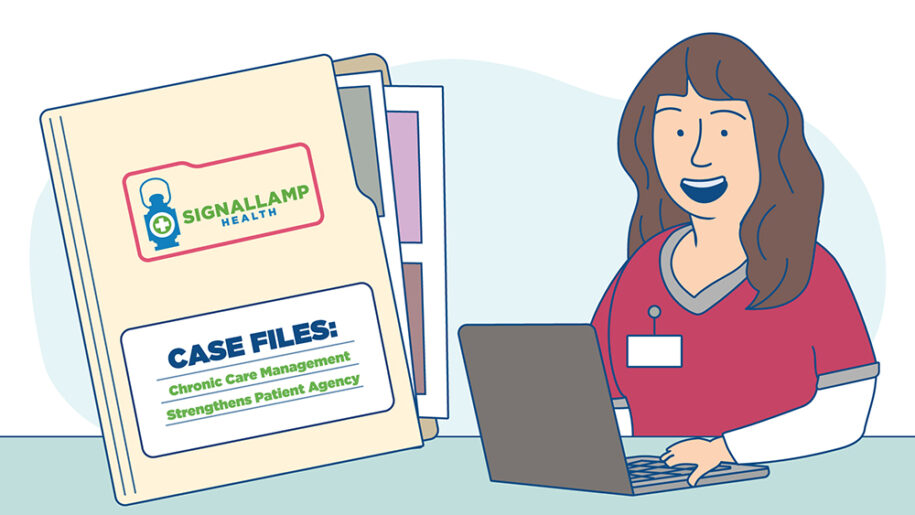
Signallamp Case Files: Chronic Care Management Strengthens Patient Agency
CCM gives patients an advocate who goes to bat for their well-being
Alarm bells went off in Naomi’s mind. The Signallamp Health remote nurse had just ended a phone call with James, one of her chronic disease patients, who called to ask about his frequent diarrhea. It was a new symptom, and Naomi suspected it wasn’t happening in a vacuum.
While on the phone, Naomi quickly ran through a checklist, sleuthing for other symptoms to help her understand what was causing James’ troubling and discomforting symptoms. Upon questioning, James revealed that he didn’t think he had been urinating as frequently as he should. And with that, he gave Naomi a solid lead.
What happened next makes James and Naomi’s story an immediate bright spot in the Signallamp Case Files. To protect their privacy, patient and nurse names have been changed. The facts are all true.
Their story illustrates the power of an effective Chronic Care Management program. Rather than call his doctor’s office or specialist, James first thought to call his remote nurse case manager. He trusts her, and over time he learned that she is a reliable first stop when he has questions about his health or therapy.
Patients can adapt quickly to an effective CCM plan
This is one of the most exciting parts about this nation’s shift away from costly care delivered in the emergency room or clinical setting. Patients are getting educated on when and how to seek the right level of care. James’ behavior gives us proof that patients can relearn how they think about health care.
Patients learn through consistency and proactive, monthly engagement from the provider side.
Because Signallamp – and by extension the providers and health systems that partner with us – maintains a persistent presence, patients learn a new default. They become far more engaged and learn to call their Signallamp nurse care manager right away when new symptoms arise instead of waiting until their next doctor’s visit.
While Naomi adds an extra link in the care supply chain, she provides an invaluable screen for non-emergency matters. She gives medical advice and guidance to patients, steering them away from clinical care. Naomi, as a Signallamp Health employee, also keeps providers’ lines open for more pressing cases.
Naomi and James’ story is somewhat of an exception – James actually needed an acute level of care (more on that in a minute). The typical Signallamp Health patient trends away from acute care because they tend to stay compliant with their medication and more vigilant about symptoms before they reach dangerous levels.
Conversations about care, rooted in a pursuit of wellness
Given his symptoms, Naomi didn’t have to guess that James was probably feeling pretty low. Gastrointestinal disease leaves most patients feeling helpless, anxious and generally uncomfortable.
If there was a solution to James’ discomfort, Naomi was going to find it.
It started with a call to his doctor, who, not surprisingly, recommended a trip to the emergency room.
A bladder scan led to James going home with a foley catheter and instructions to call a urologist – not the ideal discharge situation. Naomi knew that. In fact, everybody knows that.
“Going home with a foley catheter bag is not something that anybody wants to do,” Signallamp Health Chief Nursing Officer Jen Nicastro said matter-of-factly.
No daylight between CCM and genuine advocacy
In a follow-up conversation, James told Naomi he was confused. The urologist’s office told him to follow up in a month. Naomi was stunned and a little suspicious.
“You can’t just wait a whole month with that catheter,” she told him, thus proving another facet of effective chronic care management.
Care doesn’t stop at discharge.
In fact, after discharge is often when Signallamp remote nurse case managers do their best work. This is when questions pop up. It’s when patients learn to adapt to new, maybe temporary, behaviors. They often have new medical equipment to learn about, as in James’ case with his foley.
And when it comes to follow-up care, a remote nurse case manager can strengthen their patients’ agency, just like Naomi did for James.
She followed up with the specialist’s office and helped James get an appointment for the following week. To think, without an advocate, James might have waited a whole month to ask for clarification.
In addition, Naomi walked James through proper care and cleaning procedures for his catheter and how to empty and change his leg bag.
“He was pretty appreciative,” Naomi said. “Who knows how full he could have gotten without that catheter.”
Is your practice looking for new ways to give your patients agency through an effective Chronic Care Management model? Schedule a conversation with us today to find out how Signallamp Health can deliver life-changing care to your patients.

